Your Guide to Competitive Pickleball Tournaments in Nevada (and Arizona)
Discover top pickleball tournaments in Nevada for intermediate and advanced players. Explore local events in Las Vegas, Henderson, Mesquite & even Arizona.
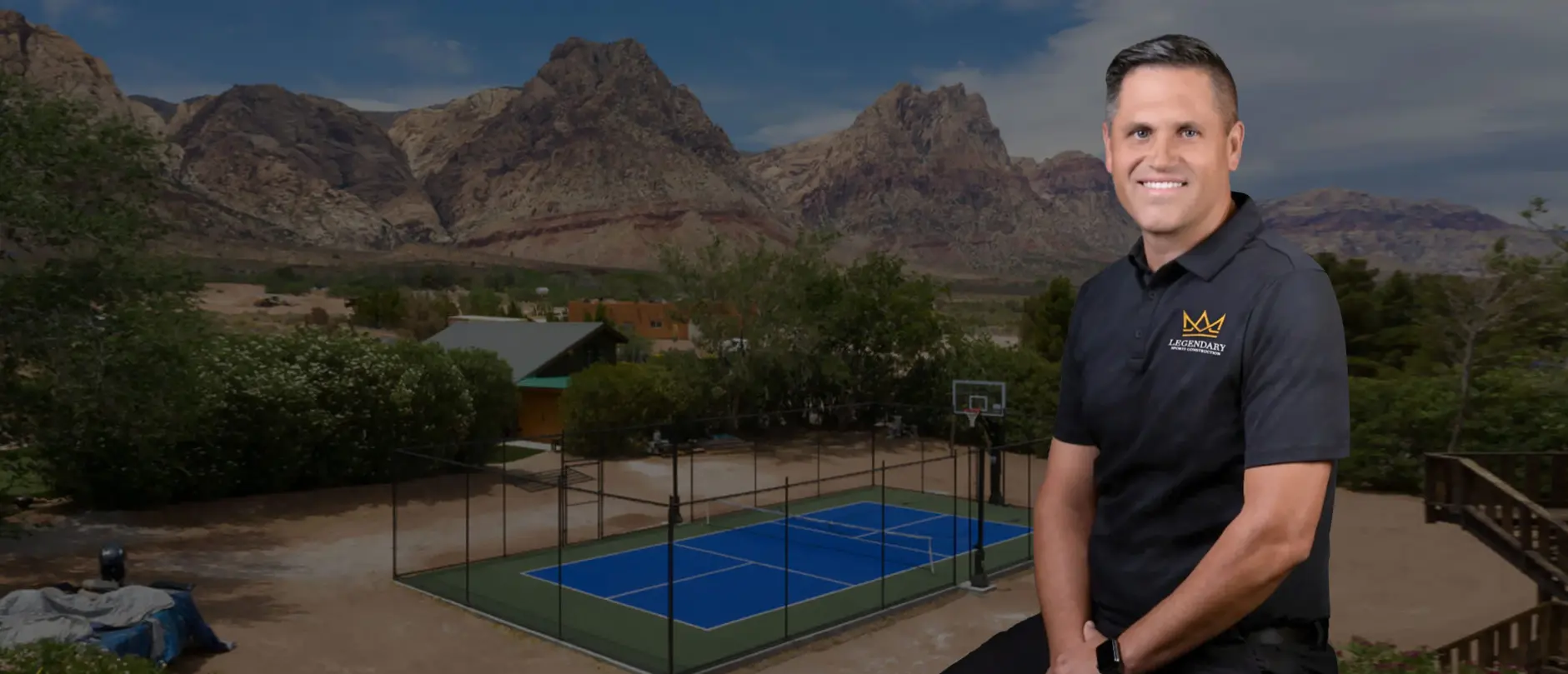
Natasha Gayle
on
June 4, 2025
Discover top pickleball tournaments in Nevada for intermediate and advanced players. Explore local events in Las Vegas, Henderson, Mesquite & even Arizona.
Natasha Gayle
on
May 22, 2025
Looking for the best pickleball courts near you in Las Vegas? Whether you’re a seasoned player or just getting started, Las Vegas offers a wide variety of local pickleball courts to suit every skill level and schedule.
Natasha Gayle
on
April 7, 2025
April is National Pickleball Month—a special time for players, enthusiasts, and communities across Nevada and Las Vegas to celebrate one of America’s fastest-growing sports.
Natasha Gayle
on
January 31, 2025
If you haven’t visited a Chicken N Pickle before, you’re in for a treat. The company seeks to be the ultimate hangout spot where communities can come together for delicious food and friendly competition on the pickleball court. Our team was privileged to be a part of their latest groundbreaking in Henderson, Nevada, just outside of Las Vegas.
Natasha Gayle
on
December 18, 2024
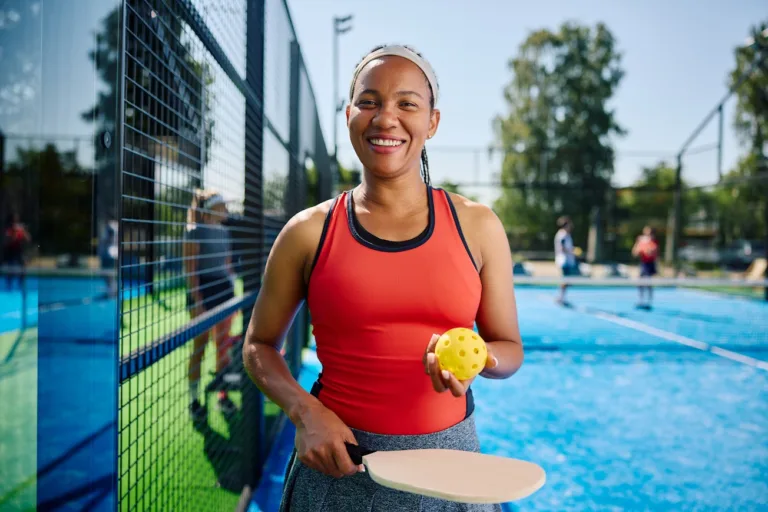
A key factor in pickleball’s surge in popularity is the rise of celebrity pickleball involvement. High-profile figures embracing the game have elevated its status, turning pickleball into a mainstream phenomenon. This pickleball celebrity influence has drawn widespread attention, taking the sport to new audiences and new heights.
The involvement of celebrities in pickleball extends beyond casual play, as many are actively investing in the sport, contributing to its rapid growth and legitimacy. This trend of celebrity pickleball investments highlights the confidence these high-profile individuals have in the sport’s future.
Several celebrities have purchased or invested in teams within Major League Pickleball (MLP), the premier professional pickleball league in the United States.
The NBA superstar has invested in an MLP team, showcasing his belief in the sport’s potential. His involvement has significantly boosted pickleball’s visibility, encouraging fans and athletes alike to explore the game.
The legendary seven-time Super Bowl Champion co-owns an MLP team and actively promotes the sport. Tom Brady’s participation in promotional events and matches has brought considerable attention to pickleball, highlighting its competitive nature.
Former NFL quarterback and Super Bowl Champion Drew Brees is deeply involved in pickleball, both as a player and an investor. He has co-founded an indoor pickleball facility near New Orleans. His engagement further solidifies the sport’s appeal among professional athletes.
NFL stars Patrick Mahomes and Travis Kelce have invested in the pickleball franchise Chicken N Pickle, contributing to its expansion. Their support underscores the sport’s growing popularity within the professional sports community from some of the most prominent and successful athletes in sports.
The investment by these pickleball celebrities not only brings financial support but also adds credibility to the sport. Their backing accelerates the development of professional leagues, improves the quality of competition, and draws media attention, all of which contribute to pickleball’s growth.
Celebrities are also entering partnerships with pickleball equipment manufacturers, launching signature products and endorsing brands.
The former tennis champion has embraced pickleball and is sponsored by JOOLA Pickleball, a leading equipment manufacturer. His expertise and fame bring attention to the sport and the brand, inspiring both tennis and pickleball enthusiasts.
Various celebrities are collaborating with pickleball brands to develop signature paddles and gear, catering to the growing market of pickleball players. These partnerships help in promoting the sport and making high-quality equipment accessible.
These endorsements not only promote the equipment but also enhance the sport’s image, making it more appealing to potential players. The involvement of celebrities in product development and promotion is a testament to pickleball’s increasing commercial viability.
The influence of celebrities on pickleball extends to hosting events that raise the sport’s profile and contribute to charitable causes. These events are pivotal in bringing pickleball to a broader audience and demonstrating its potential for community engagement.
Celebrities have organized and participated in charity pickleball tournaments, using the sport as a platform to support philanthropic endeavors.
Events like the USA Pickleball Dinks for a Difference Celebrity Match feature matches between stars from various fields. These events draw significant attention, raising funds for causes, such as healthcare, education, and community development.
Celebrity participation in local tournaments increases attendance and media coverage. Funds raised from these events contribute to various charitable organizations, showcasing the positive impact of pickleball beyond the court.
Collaborations with sports networks and broadcasters have led to televised pickleball matches and exhibitions featuring celebrities.
Televised matches highlight games between celebrities and professional pickleball players, providing entertainment and introducing the sport to new audiences.
Celebrities have also been participating in exhibition matches during major sporting events, increasing the sport’s visibility to a broader audience. These exhibitions often include commentary that educates viewers about pickleball’s rules and appeal.
These televised events not only entertain but also educate the public about pickleball, encouraging more people to take up the sport. The involvement of pickleball celebrities in these broadcasts amplifies the sport’s reach and cements its place in mainstream sports culture.
The involvement of celebrities in pickleball has significantly amplified its presence in pop culture and media. The phenomenon of celebrity pickleball has created a buzz that transcends the sport itself, reaching new audiences and inspiring a broader demographic to engage with the game.
Celebrities have taken to social media platforms to share their pickleball experiences, initiating viral posts and challenges that encourage fans to participate.
Celebrities have shared videos and photos of themselves playing pickleball casually with friends, sparking interest among their followers. These posts often go viral, introducing the sport to millions of fans worldwide.
Taylor Swift
Source: Instagram
Kristen Bell and Dax Shepard
Source: Instagram
Katy Perry
Source: Instagram
The use of hashtags such as #PickleballCelebrity and #CelebrityPickleball has gained traction on platforms like Instagram and Twitter. Fans and players alike use these hashtags to share their own pickleball moments, creating an online community centered around the sport.
The rise of pickleball in entertainment circles has led to increased media coverage across various outlets.
Prominent publications and television programs have featured stories on the growing trend of celebrities embracing pickleball. Sports networks have covered the investments of athletes like LeBron James and Tom Brady in Major League Pickleball teams, highlighting the sport’s expanding professional landscape.
Pickleball has become a topic of conversation among celebrities, with mentions on podcasts, interviews, and entertainment news. This visibility raises public awareness and piques the curiosity of those unfamiliar with the sport.
It’s remarkable that a sport which first gained popularity in retirement communities has now reached mainstream culture, thanks in part to the social media presence and media coverage generated by pickleball celebrities. Their influence has helped transform the perception of pickleball, making it an accessible and enjoyable activity for people from all walks of life. This shift highlights the sport’s evolution from a niche pastime to a dynamic, widely celebrated game.
The endorsement and participation of celebrities in pickleball have had a profound impact on the sport’s growth. The ripple effect of their involvement has led to increased public interest and the development of new facilities to accommodate the rising number of players.
The visibility of celebrities playing pickleball has inspired people of all ages to try the sport. Its reputation as a fun, social, and easy-to-learn game appeals to families, seniors, and young adults alike. According to the Sports & Fitness Industry Association (SFIA), pickleball participation has grown significantly in recent years, a trend that continues upward.
Pickleball clubs and facilities have reported a surge in memberships and court reservations. The sport’s newfound popularity has led to waiting lists at some venues, as more people seek opportunities to play.
The increasing number of players has created a demand for more courts. Municipalities are converting underutilized spaces, such as tennis courts, into pickleball courts to meet the community’s needs. Private clubs, residential communities, and even homeowners are also investing in pickleball facilities.
Companies like Legendary Sports Construction play a pivotal role in this expansion by designing and installing customized pickleball courts. Their expertise ensures that facilities meet the specific needs of players, from casual enthusiasts to professional athletes.
The impact of celebrity pickleball on the sport’s growth is evident in the rising participation rates and the proliferation of new facilities. As more people discover the joy of pickleball, the sport continues to evolve, fostering community engagement and promoting an active lifestyle.
The trajectory of celebrity pickleball suggests that the sport will continue to attract high-profile individuals, leading to more partnerships, endorsements, and investments. The enthusiasm displayed by celebrities not only validates pickleball’s appeal but also paves the way for its evolution into a mainstream sport.
The involvement of pickleball celebrities accelerates the sport’s integration into mainstream culture. With discussions about pickleball potentially becoming an Olympic sport, the global profile of the game is set to rise dramatically. The professionalization of pickleball through leagues like Major League Pickleball (MLP) and the investment of celebrities contribute to higher competition levels and greater public interest.
As pickleball continues to gain popularity, it may become a regular feature in major sporting events, exhibitions, and international competitions. The development of youth programs and school clubs indicates a growing grassroots foundation, ensuring the sport’s longevity. The combination of celebrity influence and widespread community engagement positions pickleball for significant growth in the coming years.
Pickleball’s rise is a testament to its universal appeal. Whether you’re inspired by your favorite pickleball celebrity or intrigued by the sport’s social and health benefits, now is the perfect time to pick up a paddle. Join the growing community of players enjoying this exciting game.
If you’re interested in bringing pickleball to your community or home, Legendary Sports Construction is here to help. We specialize in designing and installing custom pickleball courts tailored to your needs. Contact us today to start your pickleball journey.
Legendary Admin
on
December 18, 2024
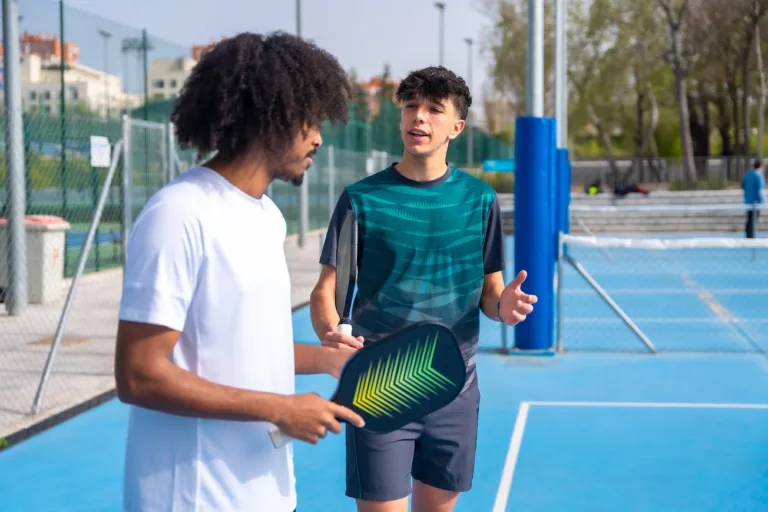
In recent years, pickleball has seen a meteoric rise in popularity, evolving from an improvised backyard game into an international phenomenon. From community centers to exclusive sports clubs, the sport has attracted players of all ages and skill levels. What started as a quirky little game played by a small in-crowd has quickly become one of the fastest-growing sports in America. The reason for this surge? Pickleball’s unique blend of accessibility, social interaction, and fun. With courts popping up everywhere and participation skyrocketing, it’s clear that pickleball isn’t just a fad.
Pickleball was invented in 1965 by Joel Pritchard, Bill Bell, and Barney McCallum on Bainbridge Island, Washington. They combined elements of badminton, tennis, and table tennis, using a wiffle ball and ping-pong paddles to create a fun, accessible sport. Originally popular in retirement communities, pickleball has since grown into a sport enjoyed by millions worldwide.
Pickleball’s widespread appeal comes from its ease of learning, inclusive environment, and social nature. Its simple rules and low barrier to entry make it accessible to people of all ages and skill levels, while its smaller court size encourages social interaction and allows for more courts in a given space. This combination of factors has helped pickleball gain traction in communities, schools, and recreational centers across the country.
For a deeper dive into how these factors are driving pickleball’s growth, read our detailed blog post here.
As pickleball’s growth continues, the expansion of courts across the country has followed suit. From residential backyards to commercial venues, the demand for dedicated pickleball courts is transforming spaces, often converting tennis courts to accommodate the sport’s growing playerbase. Cities like Las Vegas are seeing five tennis courts repurposed into 16 pickleball courts, a trend that highlights the efficiency of smaller, more social playing areas.
Pickleball courts are highly customizable, with designs that can fit a variety of spaces and player needs. Whether adjusting dimensions to fit a smaller backyard or incorporating personalized colors and logos, courts are tailored to match their environments. Different surface options, from standard acrylic to cushioned materials, allow for enhanced comfort and reduced player fatigue—particularly important for those looking to avoid the wear and tear of traditional hard courts.
Technological advancements have improved both the playing experience and the sustainability of court installations. Noise reduction has been a significant focus, with innovations like glass walls that reduce sound by 50% while maintaining visibility. Some courts also feature eco-friendly LED lighting, reducing energy consumption and light pollution.
Equipment has evolved alongside courts. Quieter paddles and enhanced surface materials provide a better playing experience, addressing concerns around noise and durability. These developments ensure pickleball is not just fun but also more accessible to communities concerned about noise or environmental impact.
By incorporating smart court designs and advanced technologies, pickleball is adapting to meet growing demand, ensuring the sport’s continued expansion and success.
Pickleball’s popularity is bringing communities together, with venues like Chicken N Pickle serving as hubs for casual players and families. These facilities, which combine pickleball courts with dining, entertainment, and social spaces, offer an inviting atmosphere for those looking to enjoy the game without the intensity of competitive play. They’ve become places where people can connect, engage in friendly matches, and spend time with family and friends. With activities ranging from pickleball to life-sized games like Connect Four, these venues are creating spaces where the community can come together, making the sport accessible and fun for all.
For players seeking a more competitive environment, pickleball’s rapid growth has also sparked an increase in local and national tournaments. From weekend competitions to USA Pickleball-sanctioned events, there are numerous opportunities for players to showcase their skills. Schools are also helping to drive the sport’s expansion, incorporating pickleball into their physical education programs and establishing youth leagues. These initiatives are introducing younger generations to the sport, ensuring its continued development for years to come.
One of pickleball’s most appealing features is its inclusivity. The sport is welcoming to players of all ages and abilities, with clubs and social groups popping up across the country to foster a sense of community. Programs for beginners make it easy for newcomers to learn the game, while local clubs provide opportunities for casual players to join in, socialize, and bond over their shared love of pickleball.
Pickleball’s rise has attracted high-profile endorsements from celebrities, with athletes like LeBron James and Tom Brady investing in professional pickleball teams. Reese Witherspoon and George Clooney are among the growing list of famous pickleballers who have been spotted playing, adding to the sport’s visibility. This celebrity involvement has helped pickleball trend further into the mainstream, contributing to its ongoing growth.
The future of pickleball looks bright, with the sport continuing to gain momentum. One of the most exciting prospects is its potential inclusion in the Olympics. While the 2028 Summer Olympics in Los Angeles have a finalized roster of events, pickleball could potentially make its Olympic debut in 2032 in Brisbane, Australia. As global interest in the sport grows, its consideration for the Olympics showcases how far pickleball has come since its humble beginnings.
Pickleball courts are rapidly expanding across the U.S., and the sport’s global reach is growing as well. More communities are integrating courts into public parks, schools, and sports clubs, while commercial facilities are transforming existing spaces to meet the increasing demand. This expansion is not limited to the U.S.—pickleball is gaining traction internationally, with more countries recognizing its appeal. As the sport spreads worldwide, the infrastructure to support it will only continue to improve.
Legendary Sports Construction plays a key role in the growth of pickleball by providing expert pickleball court design and customization. Whether adapting to unique spaces or integrating the latest materials and technologies, our courts are built to enhance the playing experience.
Beyond construction, we are committed to community development. We donate resources to schools, help launch youth pickleball clubs, and educate teachers about the sport. By building both residential and commercial courts, our team ensures that more people have access to pickleball as demand continues to rise.
Advocating for more pickleball courts in your local community can start with engaging schools, parks, and recreational centers to add courts. Fundraising and volunteer efforts are great ways to support these initiatives.
Spreading awareness is also key—use social media, attend local events, and offer mentorship or beginner classes to introduce new players to the sport. Supporting youth programs and promoting inclusive participation will ensure pickleball remains accessible and continues to grow.
Pickleball’s future is undeniably bright, with its widespread appeal and rapid growth showing no signs of slowing down. The sport’s accessibility and community-driven nature make it a favorite for players of all ages and skill levels. Now is the perfect time to get involved—whether by playing, advocating for more courts, or supporting local programs.
For those looking to bring pickleball into their own communities, Legendary Sports Construction is ready to assist with expert court design and installation. Together, we can continue to grow the sport and ensure that the growth of pickleball continues through the years.
Legendary Admin
on
October 11, 2024
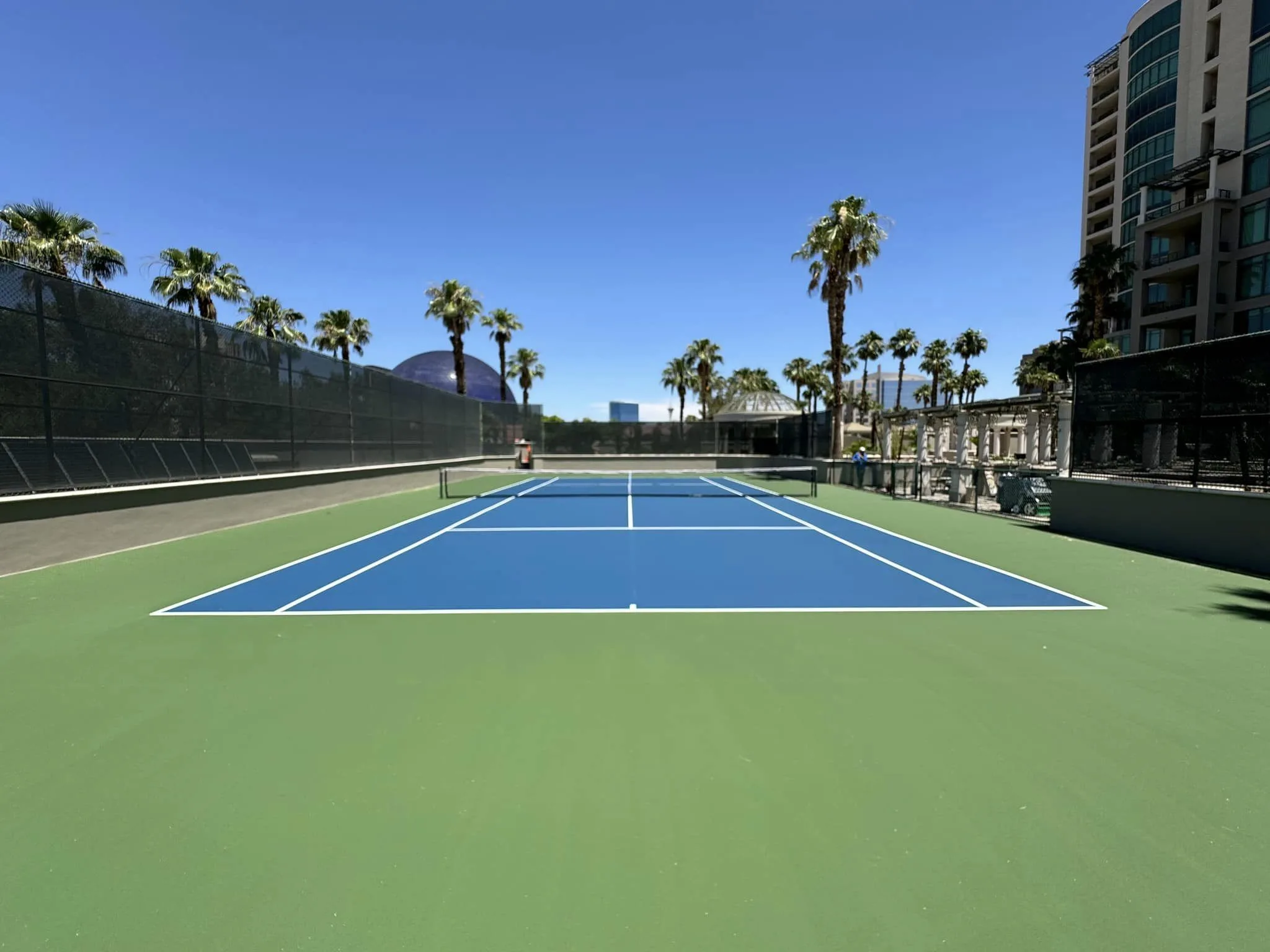
Originally created in Washington by a family looking for some variety in their backyard games, pickleball has exploded into a widely loved sport played by millions. Combining elements of tennis, badminton, and ping-pong, pickleball is accessible to people of all ages and skill levels. Its small court size and social nature make it ideal for anyone seeking connection through physical activity.
In this blog, we’ll offer key pickleball tips for beginners looking to learn, as well as tips for experienced players seeking that competitive edge. No matter your goals for pickleball, these pointers will help you improve—and maybe make a few friends along the way.At Legendary Sports Construction, we love pickleball and want everyone to experience the fun and benefits it offers. That’s why we’re committed to building high-quality, customizable courts that make the game accessible to all. Great facilities help foster community, engagement, and enjoyment—whether you’re playing for fun or competing in tournaments.
Mastering the basics and building strong foundational skills is key to enjoying pickleball and improving over time. Start by learning the rules—like staying out of the kitchen (the non-volley zone near the net). Understanding how points are scored and when to let the ball bounce will help you anticipate and really start feeling the game. If you’re completely new to the game, this article is a great place to start.
Next, learn and develop the foundational skills you’ll need for the game, including:
Drills for consistency build muscle memory. Start with simple drills like “dink rallies” to develop control over soft shots to get your opponents moving. Practicing serves and returns, targeting specific areas, improves accuracy. Focused drills on hand-eye coordination, like volleying with a partner, will sharpen your reaction time.
Next, focus on your serve, the first chance to take control of a point. Aim to serve deep into your opponent’s court, keeping them on the defensive, and remember to strike the ball below the waist. As your skills progress, you can experiment with adding power or spin. Likewise, developing a reliable return will help greatly. Aiming for deep, accurate returns forces your opponent back and prevents them from advancing to the net. Targeting their weaker side, typically the backhand, will also give you an advantage.
Consistency is key to improving your hand-eye coordination. Regular practice of your serve, returns, and net play helps you get a feel for the ball’s response, while drilling with a partner or using a pickleball machine can boost progress.
Practicing on high-quality pickleball courts makes a big difference. Smooth surfaces and good lighting ensure true bounces and reduce injury risk, helping you focus on skill-building rather than avoiding cracks and puddles. Legendary Sports Construction designs courts with performance and durability in mind for commercial and residential spaces, providing the best environment to learn and grow.
Once you’ve mastered the basics, worked on your serve, established some consistency, and found a quality court to practice on, you’ll want to understand the optimal pickleball strategy of any game. Strategic thinking helps you control the pace of games and outmaneuver opponents.
For new players, focus on keeping the ball in play and positioning yourself effectively. Consistency is more important than power, so aim for deep returns to keep your opponent from advancing to the net. In doubles, move efficiently and in sync with your partner to maintain control.
A key aspect of pickleball strategy is knowing when to play offensively or defensively. Attack when your opponent hits a weak or shallow shot, driving the ball into open spaces. When under pressure, focus on placement, keeping the ball in play until your opponent makes an error.
Using the non-volley zone (the “kitchen”) is a major component of advanced play. Position yourself close to the line to return tough shots, and master the art of dinking—soft, controlled shots that push opponents into awkward positions so they can’t return the shot.
As you advance in pickleball, refining your techniques is key to reaching the next level. Focus on improving shot accuracy, power, and control while developing a strategic mindset to outthink and outplay your opponents.
Advanced serving techniques play a major role in setting the tone. Incorporate spin and speed variations, like topspin serves that dip sharply or slices that force weak returns. Keep your body mechanics consistent to disguise your serve, and aim deep to push your opponent into a defensive position.
When returning serves, aim for power and precision. Advanced players target their opponent’s weaker side or send low returns to the feet, making it harder to counter. Adjust your returns based on your opponent’s positioning and use depth to prevent them from gaining control.
Strategic thinking becomes essential to staying competitive for advanced players. Beyond simply hitting the ball, you’ll need to anticipate your opponent’s moves, exploit weaknesses, and create opportunities to take control of the game.
Reading your opponent is a key skill. Pay attention to their body language, paddle position, and shot preferences to anticipate their next move. Setting traps by targeting their weaker side or forcing them into high-risk shots will put you in control of the point.
Creating and capitalizing on opportunities is what separates top players. Patience is key—by applying steady pressure and maintaining strong positioning, you’ll force your opponent into mistakes. When you see an opening, like a weak return or poor positioning, strike quickly with decisive shots. Keep your strategies varied to maintain the upper hand and always stay one step ahead.
Maintaining your fitness is vital for quick movements, fast reaction times, and sustained energy in competitive pickleball. While the game is accessible to all, high-level play demands more intense conditioning to stay focused and perform consistently during long rallies.
Exercises like ladder drills and cone work improve agility and footwork, while cardio—running, cycling, or intervals—builds endurance. Strength training for core, legs, and arms boosts power for serves and smashes while reducing injury risk. Better conditioning not only sharpens reflexes but also enhances decision-making, helping you anticipate your opponent’s moves and react more effectively.
Playing against a variety of opponents is one of the best ways to improve your pickleball game. Facing players with different styles exposes you to new strategies, keeping you adaptable and sharp. Whether you’re practicing dinks against a soft-hitting player or handling power shots from an aggressive competitor, experiencing different returns will keep you ready for anything on the court. Community centers and Parks and Recreation departments are vital in creating these opportunities by building quality commercial courts where players can engage with one another. By investing in high-quality community courts, cities and towns can foster a pickleball community, encouraging players of all levels to join in and improve together.
Additionally, exploring local, regional, and national competitions will further expose you to new challenges. Many resources, such as USA Pickleball, provide information on upcoming events. Joining local leagues or tournaments gives you a sense of how your skills stack up while helping you meet others who love the sport.
For those serious about refining their game, professional coaching can be incredibly helpful. A coach can provide personalized feedback tailored to your strengths and weaknesses, helping you improve in a structured manner.
Beyond just improving your mechanics, coaches can introduce advanced strategies, such as how to anticipate your opponent’s moves or adjust positioning to maximize court coverage. Many community centers offer clinics and coaching sessions, making these lessons more accessible to players who want to sharpen their skills in a group setting.
To remain competitive and continue growing in pickleball, it also helps to stay informed about new techniques, strategies, and potential rule changes. The sport is evolving, with pros constantly developing new ways to gain an edge, so staying up to date with changes will keep you ahead.
Engaging with the pickleball community is a great way to stay in the loop. Online forums, workshops, and local clubs offer plenty of opportunities to learn from others and exchange tips. Keeping up with the latest equipment advancements—such as paddles designed for better spin or enhanced control—can also give you an advantage on the court.
At Legendary Sports Construction, we’re dedicated to growing a vibrant pickleball community. Whether you’re new to the game or a seasoned player, we support your growth by encouraging you to master the basics, embrace advanced strategies, and stay physically fit for peak performance.
Ready to elevate your pickleball game or build the perfect court for your community? We’re here to help! Whether you have questions about court construction or are looking to discuss your specific pickleball needs, Legendary Sports Construction is ready to assist.
Contact us today to explore our customizable court options and how we can support your pickleball journey. Join the growing community of players and enthusiasts by reaching out for a quote. We’d love to hear from you and help you build your dream pickleball court!
Legendary Admin
on
October 11, 2024
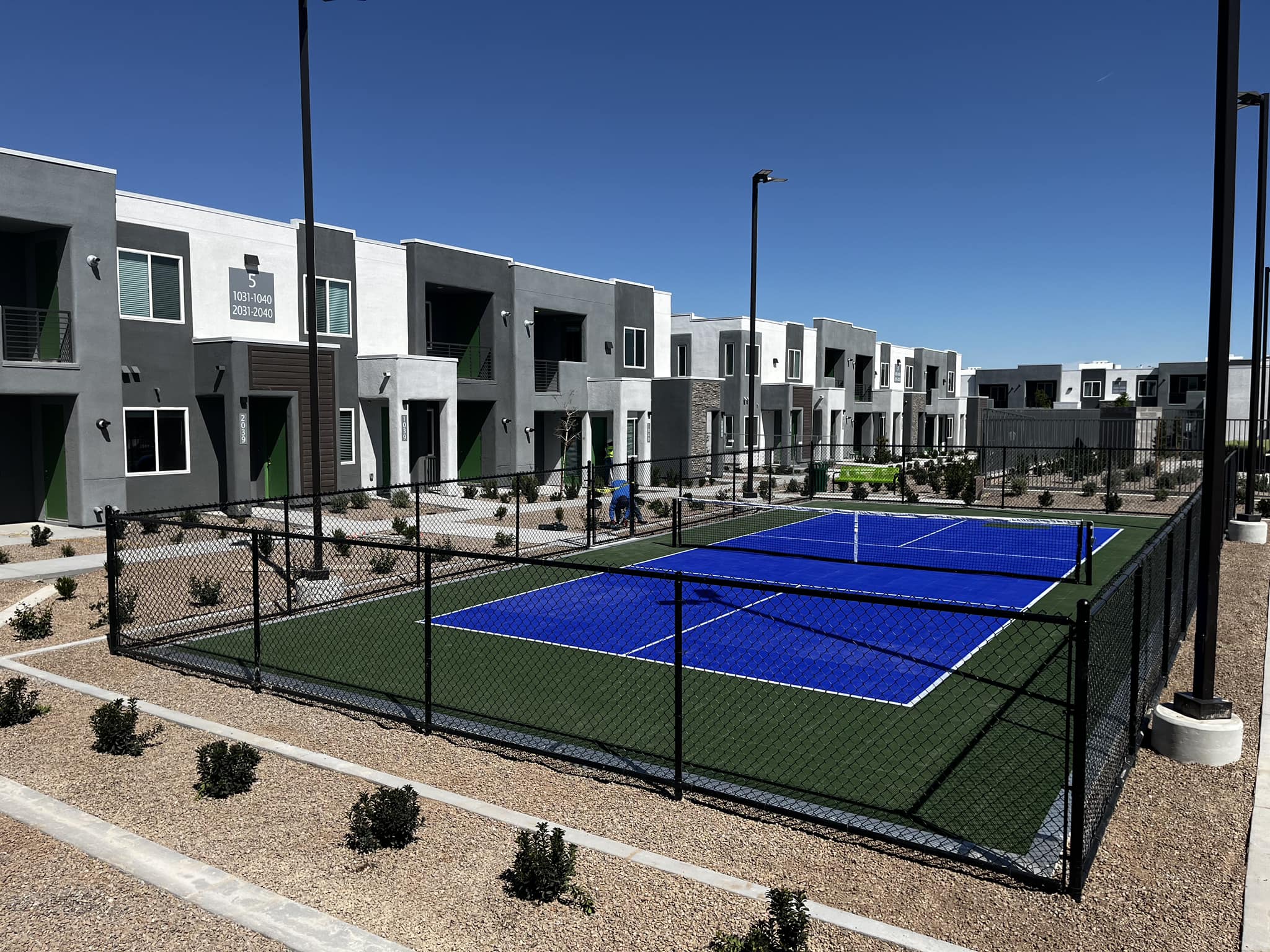
Pickleball has quickly grown from a little-known activity into a nationwide passtime, attracting players of all ages and skill levels. Just 15 to 20 years ago, it was a niche activity played by few, but today, demand for new courts is booming across parks, community centers, and elite sports clubs. The sport’s appeal lies in its easy learning curve and social, inclusive atmosphere, making it accessible to anyone who picks up a paddle.
In this post, we’ll dive into what’s fueling pickleball’s explosive popularity, the rapid growth of court construction, and what the future holds for this thriving sport. It’s clear that pickleball is here to stay, and its best days are still ahead.
One of the main reasons pickleball has skyrocketed in popularity is its simplicity. Pickleball is easy to play and learn, combining elements of tennis, badminton, and ping-pong, but with a smaller court and a slower-moving ball. New players can grasp the basics in a matter of minutes, and it’s common to see people of all ages and skill levels having fun after just a few games.
Compared to other sports, like tennis, the slower-moving ball and smaller court make pickleball easier for players of different skill levels to enjoy together, ensuring that everyone can still have fun regardless of experience. If you’re curious about how pickleball compares to tennis, check out our pickleball vs. tennis post.
Pickleball’s simplicity also extends to its equipment. All you need to play is a paddle, a ball, and a net. Unlike sports that require extensive gear or expensive equipment, pickleball’s essentials are affordable and widely available. This accessibility lowers the barrier to entry, allowing more people to join the fun without making a big investment.
Compared to other sports, pickleball gear is much more budget-friendly. A starter set costs a fraction of what you’d pay for tennis or golf equipment, making it easy for anyone to get started.
Another appealing aspect of pickleball is the variety of places you can play. From dedicated courts in public parks to makeshift setups in community centers or even your own backyard, pickleball offers flexibility in venue. The game’s small court size allows it to fit into tighter spaces, and many tennis courts are now being repurposed to accommodate multiple pickleball games.
One of the standout benefits of pickleball is that it provides a low-impact workout, which is especially beneficial for older adults or those with joint concerns. Unlike high-impact sports, such as running or basketball, pickleball is gentler on the joints and muscles, allowing players to stay active without the risk of overstraining their bodies. This makes it a great option for anyone looking to remain physically active as they age.
Here’s a comparison of sports that are safe versus those that pose higher injury risks for older adults:
While pickleball may not involve as much running or sprinting as tennis, it still offers a solid workout for your heart and muscles. The sport encourages bursts of movement, lateral shuffling, and quick reflexes, all of which contribute to improved cardiovascular health and muscular endurance over time. Regular play can enhance stamina without the high-intensity strain and endurance needed for other racquet sports.
The slower pace doesn’t diminish the health benefits, rather, it allows for sustained physical activity that’s easier to maintain for longer periods, which is ideal for players seeking consistent, moderate exercise.
Beyond the physical perks, pickleball is known for its social aspect. Playing casually with friends or joining a local league, the sport offers ample opportunities for social interaction and community building. This can help combat loneliness, foster connections, and provide a sense of belonging.
Additionally, the combination of physical activity and social engagement contributes to better mental health. Studies show that regular exercise can reduce symptoms of anxiety and depression, and the social nature of pickleball only enhances those effects, making it a great all-around activity for both body and mind.
Pickleball is known not just for its easy-to-learn nature, but for its inclusive and welcoming community. People of all ages and backgrounds can quickly join in, making it a fantastic way to meet new people. The friendly, approachable environment fosters an atmosphere where it’s easy to strike up conversations and form connections.
It’s common to see friendships blossom on the court, with players regularly inviting newcomers to join games. This openness makes it one of the easiest sports for people to dive into socially, offering a much-needed outlet for those looking to expand their social circles.
The social benefits of pickleball extend beyond casual games. Group play, local tournaments, and community events all provide great opportunities for interaction. These events, often organized by community centers or local leagues, foster a sense of belonging and provide a fun way for people to stay active while engaging with others. Tournaments are particularly popular, offering a mix of friendly competition and camaraderie.
One of the standout features of pickleball is the supportive nature of its community. Players often share stories of walking into a local gym or community center and quickly finding a welcoming group ready to help them learn and join games. As remote work, relocating, and aging make it harder for people to form connections, pickleball fills that gap by offering a social space for meaningful interactions.
One of the biggest draws of pickleball is its adaptability. It’s just as enjoyable for recreational players as it is for those seeking serious competition. Whether you’re playing a casual game with friends or competing in a high-level tournament, the sport maintains a perfect balance between fun and challenge.
For beginners, pickleball’s simple rules and slower pace provide an easy entry point, while more experienced players can push the game to faster speeds and more strategic play. This flexibility allows players to enjoy the game at their own level, making it accessible for everyone from kids to retirees to competitive athletes.
As pickleball’s popularity has grown, so has the number of tournaments and leagues across the country. Local community centers and parks regularly host events that bring players together for friendly competition, while regional and national tournaments offer a stage for those looking to take their game to the next level.
At the professional level, pickleball is expanding rapidly, with Major League Pickleball (MLP) leading the charge. MLP features team-based competitions with top-tier athletes and has drawn significant attention from fans and investors alike. Professional pickleball offers prize money and endorsements, further solidifying its place as a legitimate competitive sport.
Pickleball has caught the attention of numerous celebrities, from athletes like LeBron James to entertainers like Reese Witherspoon and George Clooney. Their participation has helped boost the sport’s visibility, drawing in new fans and players. Celebrity involvement has been a key driver in expanding pickleball’s reach beyond local communities and into the national spotlight.
Pickleball’s rise has also been fueled by increased media coverage and viral social media content. Videos of exciting matches, celebrity endorsements, and everyday players enjoying the game have spread across platforms like Instagram and TikTok, contributing to the sport’s growing popularity.
With pickleball’s rise in popularity, court construction has seen significant advancements. Companies like Legendary Sports Construction are leading the way with innovative court designs that enhance the playing experience. High-quality courts are essential for both recreational and competitive players, ensuring optimal play and durability.
For more insights on the future of pickleball court design, visit our future of pickleball article.
Modern pickleball courts are incorporating advanced materials, such as noise-reducing surfaces and eco-friendly lighting systems. Some facilities are even integrating smart court technologies, offering players enhanced gameplay experiences through tracking and analytics, further pushing the sport into the future.
Pickleball shows no signs of slowing down. According to this article, there has been a whopping 223.5% growth rate in playership over the past 3 years. With millions of new players joining every year, projections indicate continued growth, particularly as more courts and facilities are built to meet demand.
While pickleball’s roots are in the U.S., it’s rapidly gaining popularity in other countries with some people asking when it will be included in the Olympics. International communities are adopting the sport, further expanding its global presence.
Efforts to grow pickleball at the grassroots level are increasing, with initiatives targeting younger generations. Local youth programs and school partnerships are helping to introduce the sport to future players, ensuring its continued success.
Pickleball’s rapid rise in popularity shouldn’t be of surprise to anyone. The sport is accessible, social in nature, and adaptable for players of all ages and skill levels, which is why we’re all in on the sport. If you’re looking for a fun way to stay active or want to scratch that competitive itch, pickleball offers something for everyone. With its health benefits, supportive community, and growing presence worldwide, there’s never been a better time to get involved.
If you haven’t tried pickleball yet, now is the perfect time to pick up a paddle and experience the excitement for yourself. Ready to join the pickleball community? Contact Legendary Sports Construction for expert court construction and start your journey with this incredible sport.
Cyril Balatero
on
September 15, 2024
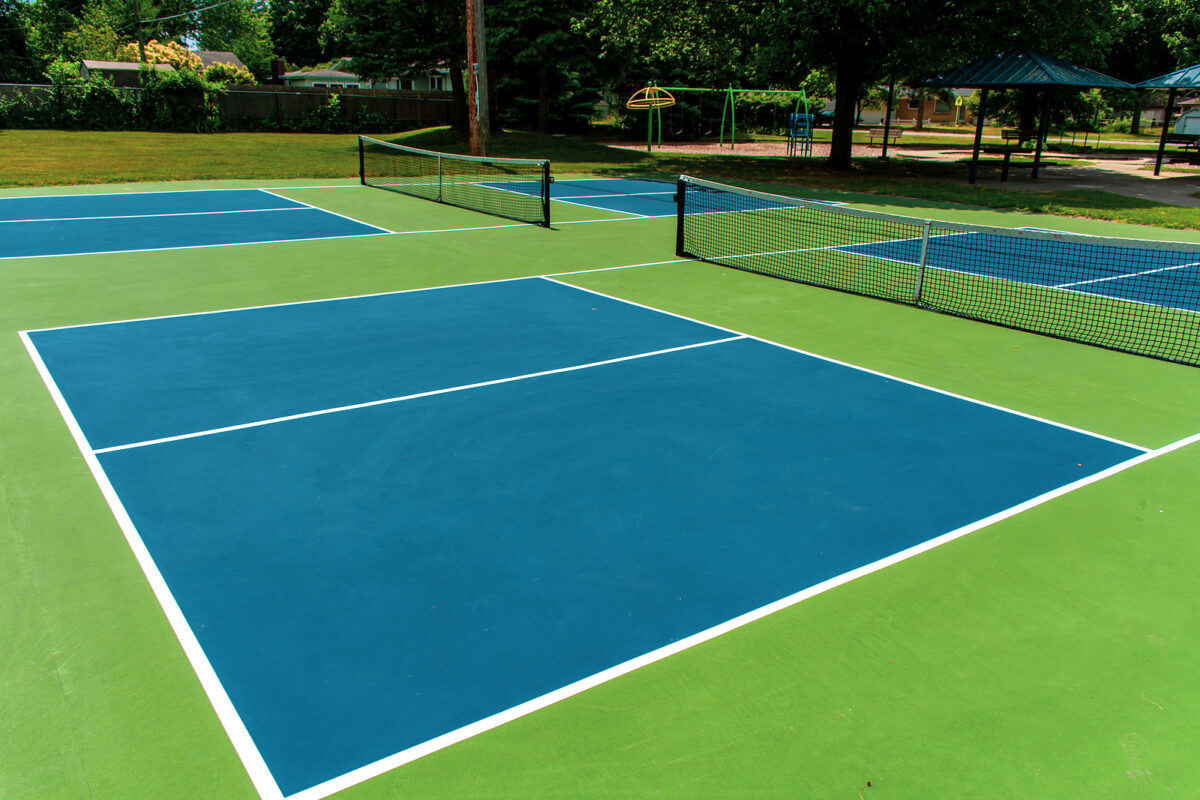
Pickleball is a fast-growing sport that combines elements of tennis, ping pong, and badminton, creating a lively and exciting game that is perfect for competition or for playing with friends and family. Whether you’re building a pickleball court for a residential backyard or a commercial facility, knowing the correct pickleball court dimensions is the first step. Here is everything you need to know about court sizing, surfaces, and more!
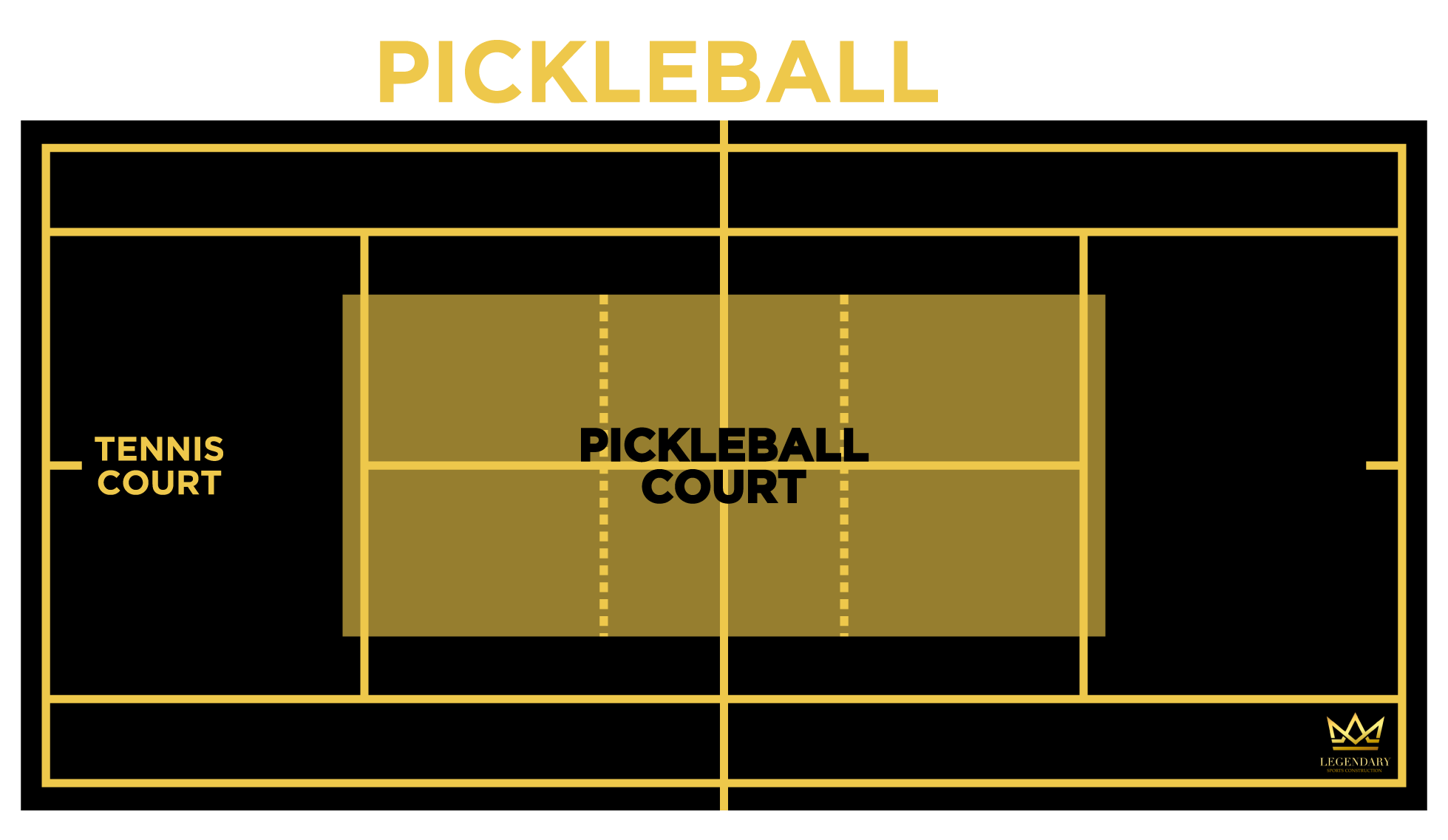
The official pickleball court size is 44 feet long by 20 feet wide, with space for an out-of-bounds zone. To host regulation play, you’ll need a total playing area of 64 feet by 34 feet—this ensures enough room at the baseline and sidelines.
Breakdown of the dimensions of a pickleball court:
These are the required pickleball court dimensions according to USA Pickleball, the governing body of the sport.
Not every property can accommodate the official pickleball court size. If you have limited space, you can create a modified pickleball court size that still offers great gameplay.
This flexibility means you can enjoy pickleball in backyards, driveways, or smaller recreational spaces—even without room for a full-size build.
>> Explore custom pickleball courts
Your chosen surface won’t change the dimensions of a pickleball court, but it does impact performance, durability, and comfort.
Popular pickleball court surfaces include:
If you’re planning a court in Nevada, Legendary Sports Construction is your trusted partner for Las Vegas pickleball design and installation. We specialize in both residential and commercial courts, offering:
With nearly two decades of experience, we’ve built courts for homeowners, HOAs, and professional athletes alike.
Call 702-883-8386 today to request your quote for a custom pickleball, tennis, basketball, or multi-game court in the Las Vegas area.
Choosing the right pickleball court size isn’t just about fitting a court on your property—it affects safety, playability, and enjoyment. Proper spacing ensures:
| Court Type | Dimensions (ft) | Best For | Pros | Cons |
|---|---|---|---|---|
| Regulation Court | 44 × 20 (play area); total 64 × 34 | Official tournament play | Meets USA Pickleball standards; ideal for competitive matches | Requires large backyard or commercial space |
| Reduced Out-of-Bounds Court | 44 × 20 (playable) within 60 × 30 | Small backyard or HOA | Keeps full play area; flexible for smaller lots | Less room for running beyond baseline |
| Scaled-Down Court (80%) | 35 × 16 | Limited space, casual play | Fits compact spaces; fun for families | Not tournament regulation; smaller rallies |
| Multi-Sport Overlay Court | Varies | Homes, schools, or community centers | Can accommodate pickleball, basketball, tennis | Requires careful planning for line markings |
Your surface choice influences durability, ball behavior, and comfort. Here’s what to consider:
Legendary Sports Construction can help you select a surface suited to Nevada’s heat, sun exposure, and your desired style of play.
Ongoing Support: Resurfacing, maintenance, and upgrades keep your court in top condition.
A standard pickleball court measures 20 feet wide by 44 feet long, including both singles and doubles play.
A pickleball court is 20′ x 44′, while a standard tennis court is 36′ x 78′, making tennis courts much larger overall.
The most affordable method is to use an existing concrete or asphalt surface and apply pickleball court lines and a basic acrylic sports coating.
What is the best flooring for pickleball?
Concrete or asphalt with an acrylic cushioned coating is considered the best outdoor surface, offering good traction, ball bounce, and durability.
The recommended backyard size is the standard 20′ x 44′ playing surface, plus extra space around the court, ideally at least 30′ x 60′ total area.
Cyril Balatero
on
July 18, 2024
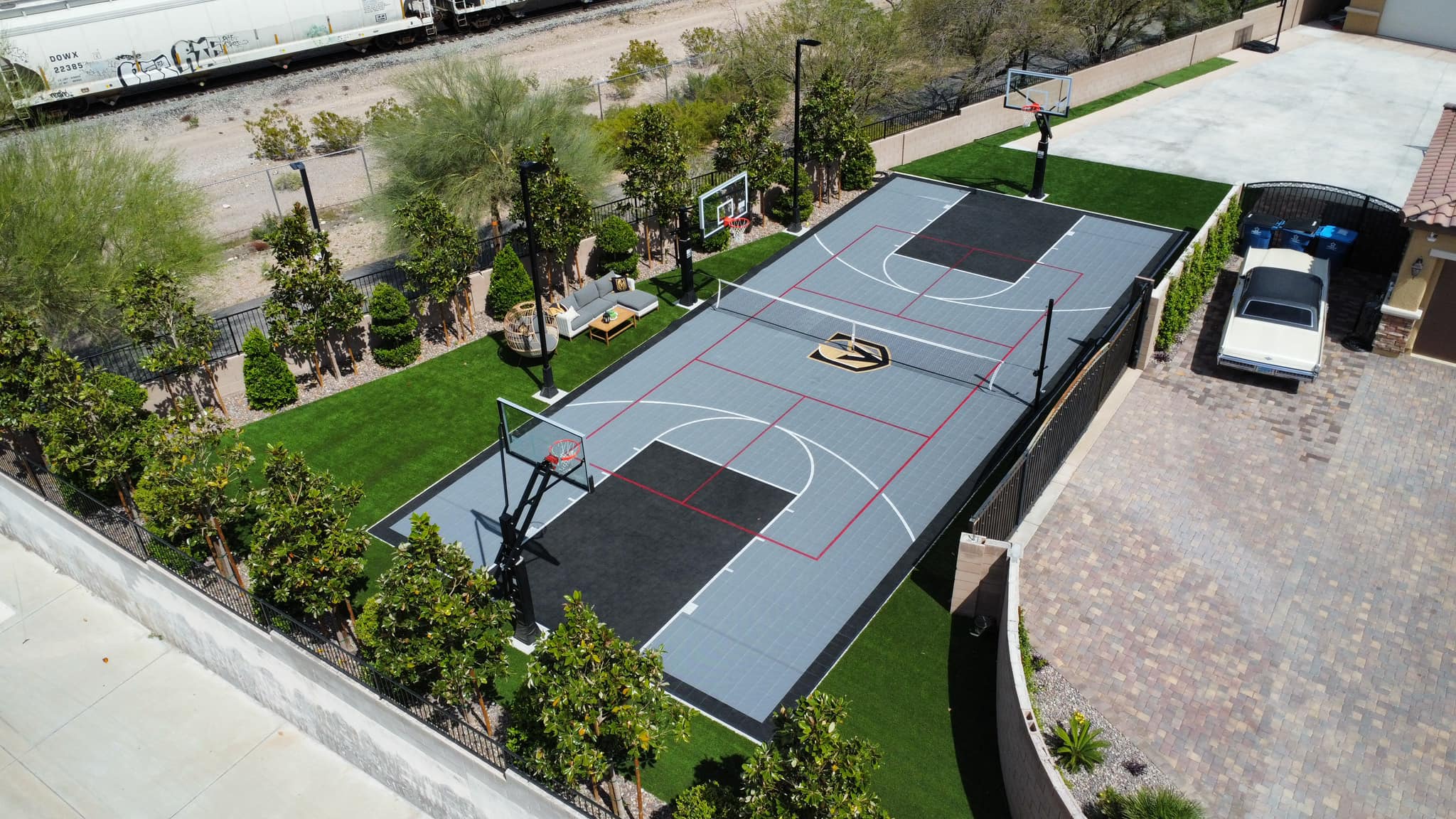
Installing a backyard multisport court for your family offers a myriad of benefits, from encouraging an active and healthy lifestyle to improving family bonding to even increasing your home value. Learn more about these benefits and more below.
While it might make sense to install an individual tennis court, pickleball court, or basketball court based on your family’s interest at the time, installing a backyard multisport court adds a lot of versatility to your outdoor space. These courts can be customized to accommodate different sports, such as basketball, tennis, pickleball, and more. And the ability to switch between activities ensures that every member of your family—you, your kids, and your grandkids—can enjoy their favorite sport, or whichever sport is most popular at the time, without the need for a separate dedicated space for each one. This flexibility makes a backyard multisport court an ideal investment for families with diverse interests.
In an era where sedentary lifestyles are on the rise, having a backyard court encourages an active and healthy lifestyle for the whole family. Whether you’re shooting hoops, playing tennis, practicing proper pickleball dinks, or all of the above, you’re getting valuable, regular exercise right at home. And the benefit of playing various sports means you get a variety of workouts on one court that can accommodate family members of all ages.
A backyard court is a perfect setting for quality family bonding. Instead of everyone retreating to separate rooms or electronic devices, the court becomes a gathering place for friendly matches, competitions, and shared experiences. It fosters a sense of camaraderie and strengthens family bonds through laughter, friendly rivalry, and shared victories.
Investing in a backyard court isn’t just a personal benefit; it can also enhance the value of your home, especially one that could be used for a variety of interests. Potential home buyers often appreciate the added appeal of a well-maintained and professionally installed recreational space, which will make your property stand out in the real estate market when it comes time to sell.
Having a dedicated space for sports and recreational activities in your own backyard brings unparalleled convenience.
For quite some time, multisport courts have been designed to accommodate sports like tennis and basketball, even volleyball. Pickleball has become a very popular option for our residential and commercial courts, which is why we’re all in when it comes to pickleball court construction for individual or multisport playing surfaces.
When choosing sports for your multisport court, you’ll want to consider the sports you, your kids, and your grandkids love to play individually, as well as sports that are easy to learn and play together. Pickleball is a great choice for families looking to play something together, or host events where anyone could jump in and join a game!
At Legendary Sports Construction, we want to make your dreams a reality. With endless possibilities and custom court designs, you can design the perfect addition to your backyard space.
Our high-quality materials and construction standards will ensure you get the court you’re looking for that is made for safe and long-lasting play.
| Court Type | Sports Supported | Space Requirements | Pros | Cons |
|---|---|---|---|---|
| Single-Sport and Game Court | Basketball OR Tennis OR Pickleball | Moderate | Simple design; lower upfront cost | Limited flexibility; only one sport |
| MultiSport and Game Court | Basketball, Tennis, Pickleball, Volleyball | Larger footprint | Versatile; accommodates all ages and skill levels; great for family & neighborhood play | Higher initial cost; requires planning for line markings |
| Scaled-Down MultiSport and Game Court | Mini Basketball, Pickleball, Short Tennis | Small backyard | Fits limited spaces; still versatile | Not regulation size; fewer players can play at once |
| Commercial MultiSport and Game Court | Basketball, Tennis, Pickleball, Volleyball | Large backyard or HOA/community space | Tournament-quality; supports high traffic | Higher cost; may require professional installation |
Pickleball’s popularity has skyrocketed for good reason:
Adding pickleball lines to your multi sport and game court maximizes play options and ensures the court stays in constant use.
A backyard multi-sport and game court is more than a play area—it’s a space for fitness, fun, and family memories that will last for years. With a court designed by Legendary Sports Construction, you’re not just building a space for games—you’re creating a central hub for activity, bonding, and home enjoyment.
A basketball court provides a dedicated space for exercise, skill development, and recreation. It encourages physical activity and offers a convenient entertainment area at home.
A covered court allows year-round play by protecting the surface from sun, rain, and weather damage. It also provides shade and improves overall comfort and safety.
A typical backyard multi-sport and game court is 30′ x 60′, which allows space for basketball, pickleball, volleyball, and other recreational games.
A multi-purpose covered court is a versatile playing area designed to support multiple sports—such as basketball, pickleball, volleyball, and futsal—under a protective roof structure.
Yes, you can install a pickleball court in your backyard as long as you have enough space, usually around 30′ x 60′ to allow for play area and safe movement around the court.
Please Provide Your Contact Information and Project Details